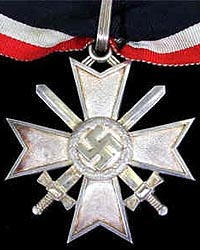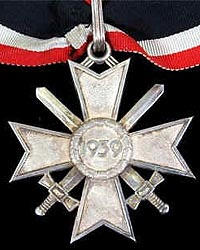
by Sebastián Bianchi
The Knights Cross to the War Merit Cross (Ritterkreuz des
Kriegsverdienstkeuzes), was introduced on August 19th, 1940 at the same time as
the War Merit Medal. Its ranking in the German award structure was above the
German Cross in Silver and Gold, but below the Knights Cross to the Iron Cross.
It was awarded sparingly over the war years, and because so few were presented
the Cross was held in high regards by the Nazi hierarchy, giving it an aura
of exclusivity which it may not have fully deserve since it ranked below the
Knights grade of Iron Cross. Great ceremonies were normally staged around
recipients, with Hitler almost always presenting the award in front of high
ranking Military and party officials. In the last year of the War, the Knights
Cross in Gold was introduced as the highest grade of the War Merit Cross. Partly
due to its late introduction date, this award was presented only a handful of
times.
|
|
|
Technical Information
The Knights Cross maintained the same design characteristics as the War Merit Cross grades, an eight pointed cross with a wreath of oak leaves in the center which surrounded on the obverse a mobile swastika, and on the reverse the year “1939”. It was produced in genuine silver ranging in grade from .800 to .935, with the manufacturers’ mark stamped at the base of the lower arm of the Cross or on the ring below the ribbon loop. It measured 54 mm across, with the oak leaves center measuring 18mm and the width of the arms being 3mm. Attached to the top arm of the Cross were two small arms in the shape of an upside down V that was grooved in the case of the combatant grade and plain in the award without swords, as can be seen in the pictures below. The V ended in an eyelet through which the ribbon loop was placed. The ribbon used to secured the Cross to the neck of the recipient had the following stripes; red (4mm), white (4mm), black (22mm), white (4mm), red (4mm).
The combatant grade of the Knights Cross was identical to the non-combatant
grade, with a pair of military swords finished on both sides fitted between the
arms of the Cross. It weighted between 42.3 and 42.4 grams while the award
without swords weighted in at 33.8 grams.
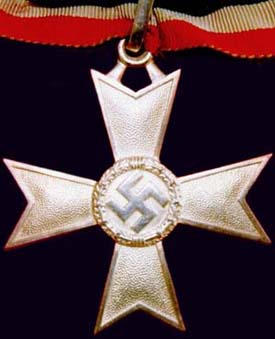 |
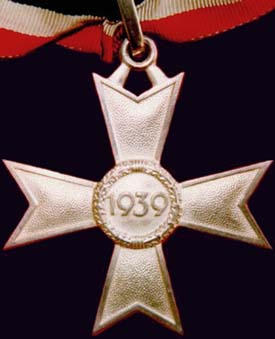 |
|---|---|
Jody Beltram Collection |
|
Presentation and Wear
The Knights Cross was presented in a blue case that had a velvet base with a
recess to accommodate the Cross. Above where the Cross rested, there was another
recess where the ribbon was placed. A document, and often a secondary price, was
presented along with the award. One good example of a recipient of a secondary
prize is Dr. Theo Morell, who was Hitler’s personal physician, and received
the only electron microscope in Germany along with his Knights Cross without
Swords.
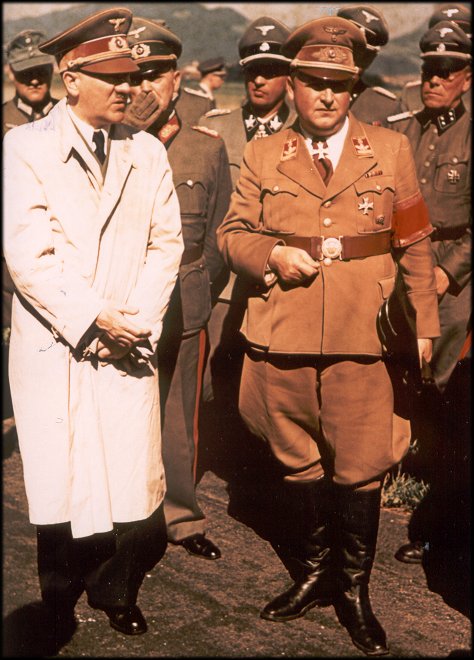
Reichorganisationsleiter (Reich Organization Leader) Dr. Robert Ley with Hitler
Sebastián Bianchi Collection
A minority of recipients were not announced in the press in order to protect the sensitive work in which they were involved. This was the case of Dr. Ing Ernst Blaicher, who was presented with the award on November 15th, 1943 for his achievements in tank production. Another example of presentation which was not publicized was the one to Luftwaffe Oberstleutnant Othmar Wolfan, who was the on the staff of Kommandierender General der Deutschen Luftwaffe in Finland. He was recalled to Berlin in the last days of the war, presented with the award, and promoted to another position before going into Russian captivity as the Third Reich capitulated.
The Knights Cross was worn at the neck, exactly like the Knights Cross to the Iron Cross. No dress down version was provided. Below is a reproduction of the Knights Cross to the War Merit Cross with Swords, presented here only to illustrate the award. To the right is SS Brigaderfuhrer Hans Kehrl (1900-1984) during his presentation of the Knights Cross with Swords on November 27, 1944. Kehrl was Chief of Raw Materials at the time, after having served in the Armaments Office and the Industrial Section.
Award Criteria
The Knight Cross to the War Merit Cross was presented to those who already held the previous two grades. All recommendations were forward through the OKW or the Reichsminister to Hitler, who personally review and approved/denied candidates. Because the candidates were often high ranking officials those who were denied were advised, unofficially and quietly, to withdraw the application.
The non-combatant grade was used to reward the achievements of civilians, civil service agents and military merit not related to combat (such as recruiting and occupation duties). It is of interest that Hitler circulated a memorandum on August 27, 1943 specifying the criteria for the award and stating that “prominent party comrades” were not to be honored with this decoration. It has been put forth that the reason for this was the Hitler had the Order of the German Eagle in mind for political leadership, and wanted to reserve the War Merit Cross for achievements that were not exclusively politically related. It had also been documented, through Albert Speer, that Hitler wanted to present Himmler with a decoration but could not decide which, and Speer himself suggested that he would not mind being recognized with an award of this type.
The Knights Cross to the War Merit Cross with Swords was presented for outstanding military bravery not directly under enemy fire. This bravery was generally of a degree not deserving of the Knights Cross.
There were 211 Knights Cross to the War Merit Cross with Swords presented,
and 48 were presented without Swords. Because as mentioned above not all awards
were made public, and because of the hectic conditions toward the end of the
war, new recipients may come to light in the future.
Recipients
Knights Cross to the War Merit Cross holder Gottlob Berger is an excellent example of an officer whose career achievements earned him decorations and through hard work and courage to be sure, but also by pleasing the right people. He was born on July 16th, 1897 in Gerstetten, Wurttemberg and served in the Imperial Army during World War I. He became a highly decorated officer, and was wounded several times earning the rare Wound Badge in Gold. After the war he spent a short period as a teacher in his hometown while joining the Freikorps, and held the post of Director of the Regional Gymnastic Institute in Stuttgart. On August 1, 1938, he joined the SS and became Director of the SS Sports Office, and on December 1 of the same year, due to his experience and high recommendations from the Army, he was officially given the rank of SS Standartenfuhrer.
The outbreak of war found him in this position, but on April 1st, 1940 Berger became Head of the Main SS Recruiting Office. This post had previously held by Heissmeyer, and Berger was involved in the administrative restructuring of the Office. It was really at this position that he excelled; On April 20th, 1940 he was promoted to SS Brigaderfuhrer. His career was aided by many pre-war connections, which allowed him to conduct many successful recruiting campaigns in the conquered Reich Territories. During the next two years he surpassed set standards and on July 1st, 1943 received the German Cross in Silver.

Obergruppenfuhrer Gottlob Berger (right)
and
Standertenfuhrer Rudolf Lehmann
Berger would eventually rise to Obergruppenfuhrer, and in this rank he was awarded the Knight Cross to the War Merit Cross with Swords on November 15th, 1944. T hat same year he briefly held the post of Commanding General in Slovakia, but with the beginning of the Slovakian uprising when he found himself relieved by General Hofle. From July 20th, 1944 until Germanys’ surrender he was Head of Prisoners of War Camps.
He was an intelligent and flexible Officer, though his personality and responsibility for several different offices are a controversial topic. He jealously protected those in Waffen-SS uniform, German or not, and did his duties with great dedication. He was a patriotic but politically opinionated, and his loyal subordination to Himmler is well documented. A tough individual, he was twice buried alive during air raids, and like most families in World War II Germany his suffered losses. In 1943 his oldest son was killed in action in the Chakov area while serving as an Officer in the Waffen SS and his son in law, Andreas Schmidt, was leader of the German Volksgruppe in Rumania and disappeared forever into the Soviet Union at the end of the war.
Obergruppenfuhrer Berger was indicted for War Crimes at Nuremberg and spent
time in Landsberg Prison. After his release he returned to his hometown of
Gerstetten where he stayed for the remainder of his life. When he was laid to
rest on January 11th, 1975 it was in front of family, friends, and several
hundred Waffen SS soldiers to whom he had dedicated so much of life.
Knights Cross to the War Merit Cross in Gold
On July 7th, 1944 Albert Speer brought to Hitler’s attention the need for a higher award, and the Knights Cross to the War Merit Cross in Gold was instituted on October 13th, 1944 (other sources state that the award was instituted on the date of Speer’s meeting with Hitler). This award ranked above the Knights Cross to the Iron Cross but below the Oak Leaves, and was identical in every way to the Silver grade save that it was gold plated. It was created with and without swords, but only the non-combatant grade was presented. One such presentation took place on Hitler’s last birthday, April 20th, 1945 when Speer presented the Cross to Franz Hahne and Karl Otto Saur, and only 21 were awarded by wars’ end.
It is believed that the Gold grade was created by simply gold plating the existing silver grades. Though only a few were presented, many more were created but never awarded. Even so, this award is rare in the extreme and virtually unattainable today.
![]()
© Copyright Wehrmacht-Awards.com LLC |
